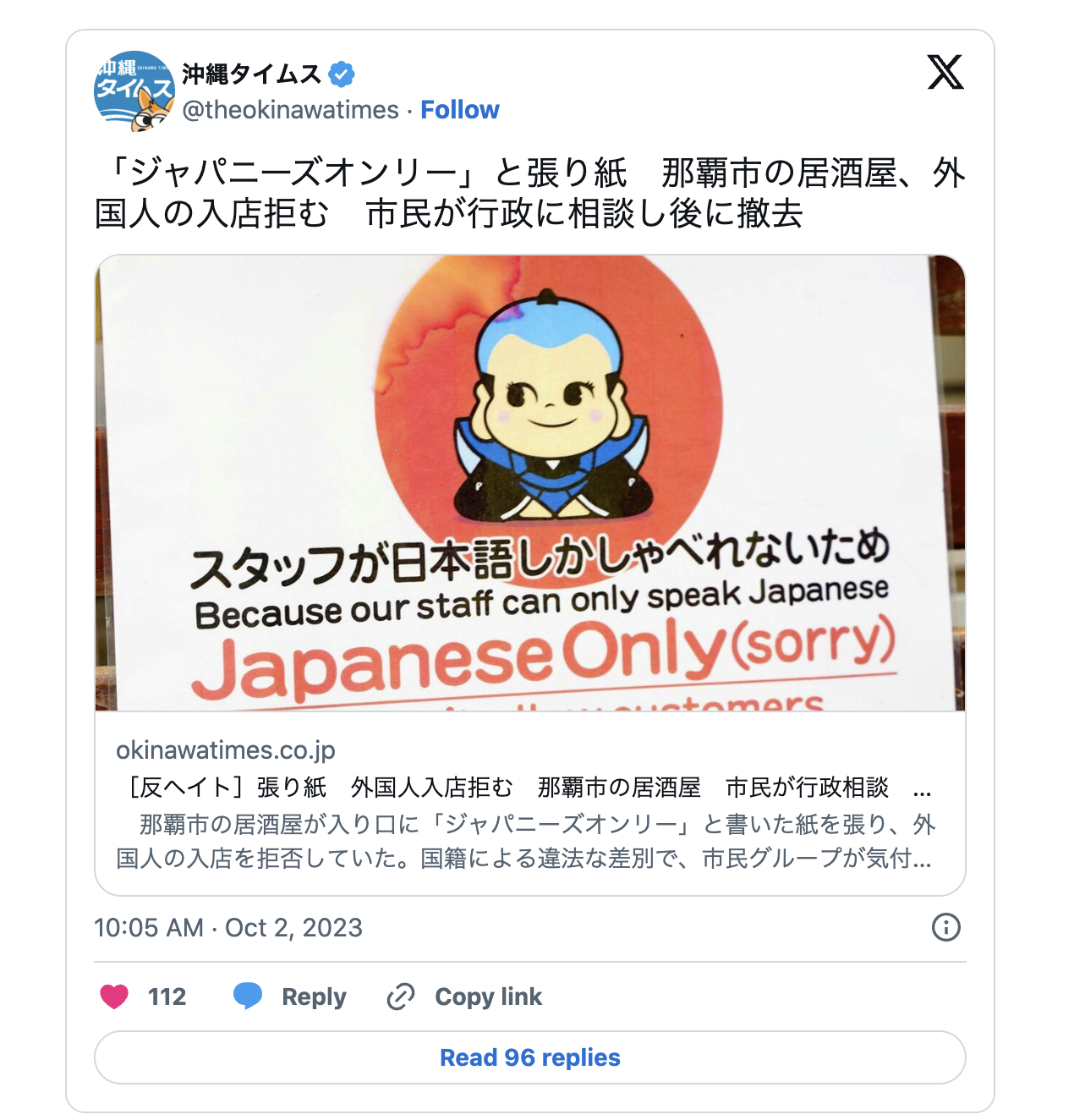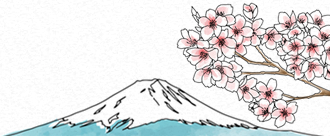mytest
Books, eBooks, and more from Debito Arudou, Ph.D. (click on icon):








UPDATES ON TWITTER: arudoudebito
DEBITO.ORG PODCASTS on iTunes, subscribe free
“LIKE” US on Facebook at http://www.facebook.com/debitoorg
https://www.facebook.com/embeddedrcsmJapan
http://www.facebook.com/handbookimmigrants
https://www.facebook.com/JapaneseOnlyTheBook
https://www.facebook.com/BookInAppropriate
If you like what you read and discuss on Debito.org, please consider helping us stop hackers and defray maintenance costs with a little donation via my webhoster:

All donations go towards website costs only. Thanks for your support!
HI Blog. In a stunning decision, a Japanese court in Mie Prefecture has ruled that a foreigner… excuse me, a JAPANESE CITIZEN who naturalized from being a Zainichi Korean, may be denied membership to a golf course that limits its membership to “Japanese Only”. Including people who are legally Japanese. Including former Zainichi Korean Permanent Residents who have been in Japan for generations.
(NB: This blog entry became a full-blown SNA column on May 24, 2023. Read it here. Evidence for claims in the article, however, is below in this website.)
For the record, this is Aigi Country Club in Gifu Prefecture.
〒509-0238 岐阜県可児市大森1501
TEL 0574-64-1211 (Website here. Plenty of overseas web presence where you can leave reviews of the golf course here.) Photo courtesy of the Asahi Shinbun.

Their case, as stated to the Asahi Shinbun below, is,
“Our club has a quota for foreign nationals and former foreign nationals who have become naturalized Japanese and restricts new memberships. We currently have no vacancies in that quota.”
This denies the privileges and equal protections under the law when you get Japanese citizenship. The court even states that Aigi Country Club’s rules were not illegal as its actions did not violate his human rights beyond “socially acceptable limits.”
Ah yes, that old legal argument. That was used in the Otaru Onsens Case to say that racial discrimination did indeed happen, but the illegal activity wasn’t the racial discrimination itself, but rather “discrimination that went beyond socially acceptable limits.” Some discrimination is acceptable, according to the courts. Here, discrimination for having Korean roots is acceptable in a club. After all, according to the Asahi below,
“private entities like the golf club are guaranteed freedom of association under Article 21 of the Constitution. In principle, such private groups are free to decide the terms and conditions of their memberships.” Especially since it’s an “exclusive and private group,” and playing golf is “not indispensable for social life.”
There’s plenty more below, but let me put this in context about how the Japanese judiciary has been slowly whittling away NJ rights:
The Ana Bortz Case of 1998-1999 found that foreigners were protected by the UN CERD against being turned away at private enterprises open to the public (in this case, a jewelry store), and awarded Bortz 2 million yen (at the time, about $15,000).
The Otaru Onsens Case of 1993-2005 found that foreigners (and one naturalized Japanese citizen) were not allowed to be turned away from a private enterprise (in this case, a public bathhouse), and awarded plaintiffs 1 million yen each. But they did not hold that the UN CERD offered protections, and the Japan Supreme Court also ruled that there were no constitutional protections involved.
The Steve McGowan Case of 2004-2006 found NO protections for his denial from a private enterprise (an eyeglass store), and blamed him for not understanding enough Japanese (even though we had him on tape saying he refused McGowan because he “hates black people”. This was overturned on appeal, but by now the court award was whittled down to only 350,000 yen, not enough to cover his legal fees for the initial lawsuit and appeal.
Now, this Aigi Country Club Case ruling says a) there are no protections for foreigners, b) even if they have Japanese citizenship, c) even if everyone admits the discrimination was nationality/ethnicity-based. It’s not discrimination because golf clubs are designed to be exclusive, by whatever standards they want. It’s “socially acceptable”.
This is a horrible precedent, and completely undermines the Japanese Government’s position that Japan doesn’t need a law against racial discrimination because we have an active judiciary. If there’s a problem, sue, and get legal protections.
“Furthermore, in cases where the rights of the people are infringed, the Court can offer them redress. (Article 32 of the Constitution provides that “no person shall be denied the right of access to the courts.”)… The Constitution of Japan stipulates not only guarantee of being equal as Japanese nationals under the law but also guarantee of equality of all rights as Japanese nationals. Therefore, there is no discrimination at all for civil, political, economic and cultural rights under the legal system.”
Nope. It was a lie all along, and now verifiably so. Debito Arudou, Ph.D.
(NB: This blog entry became a full-blown SNA column on May 24, 2023. Read it here. Evidence for claims in the article, however, is below in this website.)
Referencial articles follow:
/////////////////////////////////
Golf club’s denial of membership to former foreign citizen not illegal: Japan court
April 20, 2023 (Mainichi Japan), courtesy of MMT and Niklas
https://mainichi.jp/english/articles/20230420/p2a/00m/0na/008000c
TSU — The Yokkaichi branch of the Tsu District Court on April 19 dismissed a lawsuit filed by a man who said he suffered emotional pain after being denied membership at a country club because he is a former foreign national.
The plaintiff, a man in his 40s, sued the private Aigi Country Club in Kani, Gifu Prefecture, for roughly 3.3 million yen (about $24,400) in compensation for emotional distress.
The court ruled that there was nothing illegal about the club refusing to grant the man membership because of his former citizenship. The plaintiff, a resident of the Mie Prefecture city of Kuwana, plans to appeal.
According to the ruling, the man, a former Korean national who acquired Japanese citizenship in 2018, played at the club with an acquaintance in February 2022 and applied for membership. Later, the club rejected his application, saying, “There is no room in the membership quota for foreign nationals, including former foreign nationals, and you cannot join right now.” The man claimed that the club’s response violated Article 14 of Japan’s Constitution, which stipulates equality under the law.
Presiding Judge Tomomichi Masukawa (with Presiding Judge Kan Hibino reading on his behalf) rejected the club’s claim that “being a former foreign national is not the only reason for refusing membership,” and recognized that the refusal was due to the plaintiff’s former Korean nationality.
However, the judge pointed out that the club is a “closed and private organization with strong personal ties among its members,” as membership requires a referral from two regular members and approval by the board of directors. He concluded that “the degree of infringement on the right to equality cannot be considered to exceed socially acceptable limits in light of the purpose of the Constitution.”
In response, the plaintiff’s attorney Junji Oichi said, “It is very regrettable. It goes against the times.” The man said, “I cannot agree with this at all. Is it acceptable to suffer mental anguish from discrimination if it is within a private organization?”
(Japanese original by Taeko Terahara, Tsu Bureau)
元外国籍で入会拒否、違法性なし ゴルフ会員権訴訟 津地裁支部
毎日新聞 2023/4/19 18:15
https://mainichi.jp/articles/20230419/k00/00m/040/227000c
元外国籍であることを理由に入会を断られ精神的苦痛を受けたなどとして、三重県桑名市の40代男性が愛岐カントリークラブ(岐阜県可児市)に対し、慰謝料など約330万円の損害賠償を求めた訴訟で、津地裁四日市支部は19日、男性の請求を棄却した。私的団体であるゴルフクラブが元外国籍であることを理由に入会を拒否することに違法性はないと判断した。男性は控訴する方針。
判決によると、元韓国籍で2018年に日本国籍を取得した男性は22年2月、知人と同クラブでプレーし、入会を申し込んだ。その後、クラブ側から「元外国籍を含む外国籍の会員の枠に空きがないためすぐに入会することはできない」として入会を断られた。男性は「法の下の平等」を定めた憲法14条に抵触する、などと主張していた。
判決理由で升川智道裁判長(日比野幹裁判長代読)は、「元外国籍であることが入会拒否の唯一の理由ではない」というクラブ側の主張を退け、入会拒否は元外国籍であることが理由だと認めた。一方で、クラブは会員となるために正会員2人の紹介と理事会の承認を得る必要があるなど「会員同士の人的つながりが強い閉鎖的かつ私的な団体」だと指摘。「平等の権利への侵害の程度は憲法の趣旨に照らし、社会的に許容しうる限界を超えるとは認められない」とした。
原告代理人の尾市淳二弁護士は「非常に残念。時代の流れとも逆行する」と話した。男性は「まったく納得できない。差別を受け精神的苦痛を受けることも私的団体内であれば許されるのか」と述べた。【寺原多恵子】
/////////////////////////////////
Court sides with golf club that rejected man born Korean
THE ASAHI SHIMBUN
April 20, 2023 at 17:04 JST
https://www.asahi.com/ajw/articles/14889867
Photo/Illutration: The Yokkaichi branch of the Tsu District Court in Yokkaichi, Mie Prefecture (Asahi Shimbun file photo)
YOKKAICHI, Mie Prefecture–A naturalized Japanese citizen expressed outrage after a court rejected his lawsuit against a golf club that refused his membership because he was not born Japanese.
The Yokkaichi branch of the Tsu District Court on April 19 accepted the argument of the plaintiff in his 40s that the Aigi Country Club in Kani, Gifu Prefecture, had denied his membership application because he used to be ethnic Korean.
The court also said there was room to doubt the reasoning behind the club’s membership rules.
But the court ruled against the plaintiff, saying the golf club’s rules were not illegal, and its actions did not violate his human rights beyond “socially acceptable limits.”
“The ruling is out of step with the times,” said a lawyer for the plaintiff, who lives in Kuwana, Mie Prefecture. “The court should have found it unlawful discrimination.”
The plaintiff, who was born to ethnic Korean parents and obtained Japanese citizenship in 2018, filed the lawsuit in April 2022, demanding 3.3 million yen ($24,000) in compensation.
The man, who runs a cleaning business, argued that the golf club violated Article 14 of the Constitution, which guarantees equality to all people under the law.
The court, however, said private entities like the golf club are guaranteed freedom of association under Article 21 of the Constitution. In principle, such private groups are free to decide the terms and conditions of their memberships, the ruling said.
The court also said legal intervention into the internal affairs of a private group is permitted only in exceptional cases when an individual’s rights are violated beyond socially acceptable limits.
It said the golf club is an “exclusive and private group,” and playing golf is “not indispensable for social life.”
The ruling concluded that the disadvantages suffered by the man as a result of being refused membership did not constitute an “exceptional case.”
The plaintiff said he plans to appeal the ruling because he would otherwise continue to be mistreated as a “former foreign citizen.”
A lawyer representing the golf club said they will thoroughly examine the ruling.
(This article was written by Hiroshi Matsubara and Yusuke Saito.)
/////////////////////////////////
Nationality not the only issue at exclusive golf clubs in Japan
By HWANG CHUL/ Staff Writer
May 10, 2022 at 07:10 JST
Photo/Illutration: The Aigi Country Club in Kani, Gifu Prefecture, seen here on April 14, opened more than half a century ago. (Hwang Chul)
https://www.asahi.com/ajw/articles/14608465
Despite being a naturalized Japanese, a man born to ethnic Korean parents was refused membership to an exclusive golf club in Gifu Prefecture on grounds its quota for non-Japanese was full.
When the fortysomething man, who obtained Japanese citizenship in 2018, sought an explanation, a representative of the Aigi Country Club cited his country of origin.
“Our club has a quota for foreign nationals and former foreign nationals who have become naturalized Japanese and restricts new memberships,” she said in a phone call on Feb. 20. “We currently have no vacancies in that quota.”
When he applied for membership, the man, who lives in Kuwana, Mie Prefecture, and runs a cleaning services company, submitted a copy of an extract of his family register which stated he had South Korean citizenship when he was naturalized.
“If only you could accept (our decision),” a director of the club told him three days later in a phone call the man recorded.
In March, the man sent a written notice to the club through his lawyer, demanding an apology and payment of 3 million yen ($23,500) in compensation, contending its denial of membership constituted “groundless discrimination.”
He also requested the Mie Bar Association to address the infringement of his human rights.
The man had agonized for ages before deciding to take Japanese citizenship.
“Shouldn’t I be switching nationalities, not least for my wife and children, as long as I will go on living in Japan?” he asked himself.
WAY THINGS ARE DONE
The Aigi Country Club, based in Kani, Gifu Prefecture, opened in July 1964, making it the fourth of its kind in the prefecture. It has hosted competitions organized by the Japan Golf Association and was the venue of women’s golf events during the National Sports Festival held in Gifu Prefecture in 2012.
Masakatsu Ito, the club’s managing director, told The Asahi Shimbun that the club, with around 1,500 members, has a combined quota of somewhere below 20 for foreign nationals and former foreign nationals who have obtained Japanese citizenship. He said new members are admitted only when vacancies occur in that category.
“We set those rules as a private golf club,” Ito said. “It is said that the atmosphere slightly changes when there are foreigners around. The decision may have been made in that train of thought. It is not easy to offer a clear answer because the rules were introduced a long time ago.”
When asked why those who have obtained Japanese citizenship are includd in the quota for non-Japanese, he said: “That’s how we’ve been doing things. It is our conventional practice, and I hope it will be understood as such.”
Club officials acknowledged that those rules are not written explicitly in the club’s regulations but have been handed down as internal rules.
HARDLY AN ISOLATED CASE
The Korean Chamber of Commerce & Industry in Japan conducted a survey of 1,794 members-only golf clubs around Japan in 1994 to ascertain nationality clauses in membership requirements.
Of the 821 respondents, 170 golf courses said they had certain restrictions, such as limiting eligibility to Japanese nationals.
KCCI officials said no detailed figures are available on the current situation as a similar survey has not been carried out at least since 2010.
An online search for information on golf club memberships shows that many clubs deny memberships to non-Japanese nationals.
“A good number of golf courses still have nationality clauses, and some even restrict membership for naturalized citizens as well,” a sales official of a Tokyo dealer of memberships told The Asahi Shimbun. “They still retain that exclusive mood.”
“Private clubs handle the matter of membership with their respective criteria,” a JGA official said of the membership restrictions for non-Japanese nationals. “The JGA has never taken a position on the nationality clauses of those clubs or other related matters.”
COURT DECISIONS DIVIDED
In March 1995, the Tokyo District Court ruled on a case concerning a Tokyo golf club operating company that denied membership to an ethnic Korean man on grounds of his nationality. The court found that doing so contravened the spirit of Article 14 of the Constitution, which says all people are equal under the law.
“Golf clubs are deemed to be groups of a certain social nature, partly because golf is a leisure activity broadly practiced in Japan and partly because golf club memberships are circulating in the market,” the decision said in part. “It is difficult to say they have total discretion over how they screen their memberships.”
In a separate lawsuit, the Tokyo District Court in May 2001 rejected the claims of an ethnic Korean plaintiff, saying, “It cannot be said that equality rights are violated beyond socially acceptable limits when a golf club, as a private corporation, restricts its membership requirements on grounds of nationality.”
That decision was upheld by the Tokyo High Court in 2002.
But those “socially acceptable limits” are changing, say some industry insiders.
A law was enacted to deal with hate speech, or instigation of discrimination, against specific ethnic or other groups, and there is a growing awareness about human rights of sexual minorities.
“Golf courses are under pressure to deal with human rights issues, which are not limited to matters of nationality,” the manager of a golf club in the Tokai region said.
He said his club, which has been operating for more than four decades, stopped nationality-based screening of its memberships several years ago.
He cited the example of the Kasumigaseki Country Club in Kawagoe, Saitama Prefecture, which was the venue of golf competitions during the Tokyo Olympics last year.
The International Olympic Committee called on the golf club to rectify its rules that denied full memberships to women, which the IOC said went against the Olympic Charter. The rules were eventually changed.
“Changes in the environment surrounding golf clubs, which were symbolized by that case, will likely go on over the years to come,” the manager said.
“In the United States and elsewhere, golf courses that discriminate against people on the basis of race and gender are finding themselves left out of opportunities to host competitions,” noted Ryusuke Kin, a lawyer with the Tokyo Bar Association.
Kin wrote about the golf club membership issue in “Ethnic Koreans in Japan as seen in lawsuits,” a book compiled and edited by the Lawyers Association of Zainichi Koreans.
“It is problematic that many golf clubs in Japan still have rules that deny memberships to non-Japanese nationals across the board,” he said. “What is more, drawing a line among compatriots on grounds of whether they were non-Japanese in the past amounts to an obvious violation of human rights. The golf world needs to rectify that problem.”
ENDS
======================
Do you like what you read on Debito.org? Want to help keep the archive active and support Debito.org’s activities? Please consider donating a little something. More details here. Or if you prefer something less complicated, just click on an advertisement below.





![]()






























 \
\







































































